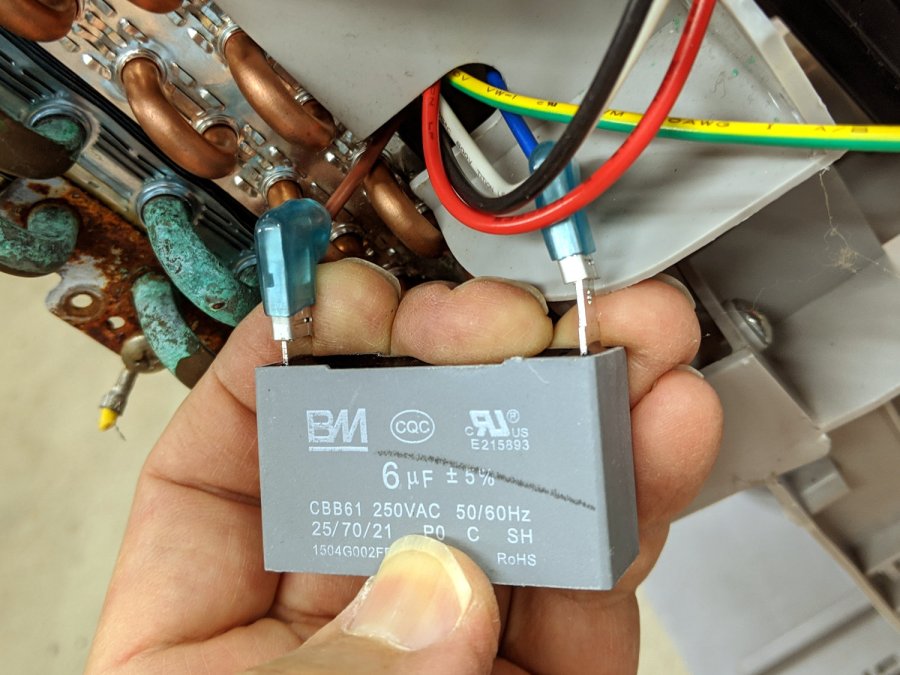Dutchess County has another Household Hazmat / Electronics Disposal Day coming up, so I harvested some useful parts from the three dead dehumidifiers lurking under the bench.
The (perfectly good) blower motor in one unit lives inside a convenient plastic housing:

It’s sitting on three foam pads hot-melt glued to three wood blocks cut to fit inside three convenient molded features, making it nice & quiet & stable.
The motor uses a nice polypropylene run capacitor:

Which is also perfectly good:

The motor includes a wiring diagram:

I lashed it together with a chopped-off IEC cord, because the stock dehumidifier cords are just way too stiff. The motor and blower originally pulled air through the dust filter, the condenser, and the evaporator, before blowing it out the side, so it’s running pretty much unloaded. A quick test shows there’s not much difference between the high and low speeds:
- High: 1050 RPM, 80 W, 12.5 m/s air flow
- Low: 1000 RPM, 77 W, 11.7 m/s air flow
Low speed seems slightly less noisy, but the wiring now has insulated QD connectors just in case I ever want to run it at full speed.
For whatever it’s worth, the most recent dehumidifier failed one year into a two year warranty, but the company decided it was simpler to just refund the purchase price than to replace the unit. It seems the “sealed system” inside loses its refrigerant after a year and there’s no practical way to seal a small leak and recharge the system; unlike an automotive air conditioner, the tubes are soldered shut after the initial charge.
They all sport Energy Star badges, but throwing away the whole damned thing every year or two tells me we’re not measuring the right values. Obviously, somebody could make a worthwhile dehumidifier, but as of now Frigidare, GE Appliances (sold to Haier), and Danby are on my shit list. Next year, I expect to add HomeLabs to the list, because the dehumidifier is identical to the Danby unit (and, ah-ha comes with a 2.5 year warranty). They’re all made by Haier (or another Chinese factory) and nobody applies any long-term QC to their products.

I’ve got one to do the same waiting for me. No point in letting all of those perfectly good components go to waste.
The compressor harvested from a long-gone dehumidifier, back before I realized how many I’d have, still awaits becoming a vacuum chuck. One of these days, fer shure …
I’m used to equipment like that sealed with a pinch off tool (hardened jaws and lots of pressure on soft copper pipe) instead of soldering, although many joints are soldered. If so, I’d be curious as to which is leaking (if either, it could be that they’re using really low quality copper that is slightly porous).
AFAICT, all the plumbing has least decent solder joints, with no obvious points where they’d leak. You may be right about “low quality copper”; I’d be unsurprised to learn it’s mmmm copper-flashed aluminum tubing.
Given my extensive collection of defunct dehumidifiers, all dead from refrigerant loss, there’s a “design defect” affecting every single one. Doesn’t matter which brand, doesn’t matter which factory, doesn’t matter what warranty, they’re all defective in the same way.
For what little it’s worth, we have a 2013 “Comfortaire” (branded as a “Mars” company–drawing a blank now, but Mars Signal Light Co. might be the parent) that we use in winter time. (Summers are usually dry.) No problems so far, but it gets used about 3-5 hours overnight, and seldom during the day. This is usually an Oct-April season.
I’ve seen an almost-identical model with a black casing instead of white, and slight differences in the panel, at Costco, probably last February.
It’s a Chinese unit (labeled as P.R.C.), but quality and reliability has been good for our simple needs. The fact it was the only one available in town when we really needed it had a lot to do with the purchase decision…
Whether such units are any good nowadays is an open bet.
Aye, there’s the question: what’s new & different in whatever factory’s making them, nine years later?
All the classic “brand names” (GE, Polaroid, Craftsman) have been forcibly detached from whatever quality / reputation they once denoted and now have little-to-no relation to anything physical. I have pretty much zero brand loyalty these days …
One side effect has been destroying Consumer Report’s ability to make meaningful tests: by the time they report on a particular widget, it’s out of production and its replacement seems substantially different.
I can think of only two exceptions to your otherwise spot-on observation about brand rot:
– Kitchenaid mixers – still made in Ohio, USA (even though the brand is owned by the bastards at Whirlpool)
– Speed Queen washers and driers – still made in Wisconsin, USA
Our Kitchenaid mixer has survived a couple of decades of reasonably steady use, but the current Consumer Reports reviews are scathing; the innards aren’t what they used to be.
The Speed Queens cost 3 dB more than equivalent machines, but have 7 dB more warranty!
Our 2003 vintage Kitchenaid mixer also has shown to be quite repairable. I had the speed switch get funky (it was skipping detents at the most commonly used low speeds), but a new lever and some judicious use of Mister File did the trick.
The PTO gearing wore out (Julie uses it for making brown rice flour), but I got new gears and the Factory Authorized grease and rebuilt the head. IIRC, I have brushes and a spare lever and enough of the FA grease for another rebuild.
I’ve read that the mixers were originally built by Hobart, and are a smaller version of the commercial monsters.
Agreed on the Speed Queen dryer. We got one when the came-with-the-house Whirlpool wore out its gasket felts. Simple, does huge loads, and has been reliable.